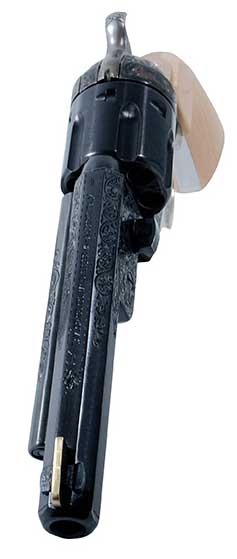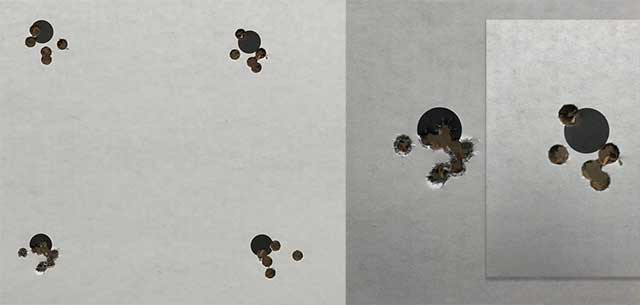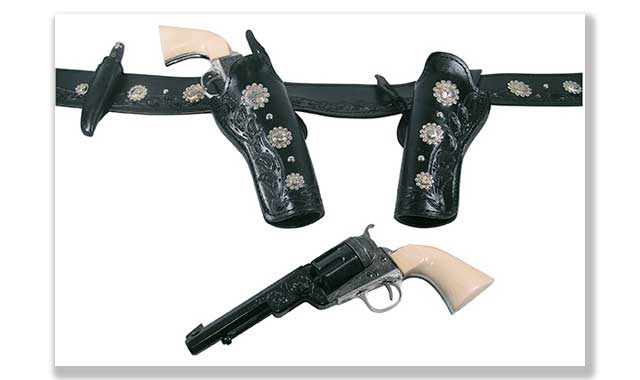THE PROOF OF THE PUDDING…
 Lacking a top strap encompassing the cylinder, the sighting plane is remarkably close to the bore. This makes the ’51 R-M Navy conversions some of the best pointing CAS revolvers. The downside of the Colt open top revolvers have minuscule sights. The addition of the dovetailed brass front blade sights combined with enlarging the notch in the hammers provides a sight picture akin to conventional Model P revolvers. Point of impact both windage and elevation are now regulated by manipulating the front sight. Tools, targets and ammunition loaded in the vehicle it is off to the range to sight-in these beauties!
Lacking a top strap encompassing the cylinder, the sighting plane is remarkably close to the bore. This makes the ’51 R-M Navy conversions some of the best pointing CAS revolvers. The downside of the Colt open top revolvers have minuscule sights. The addition of the dovetailed brass front blade sights combined with enlarging the notch in the hammers provides a sight picture akin to conventional Model P revolvers. Point of impact both windage and elevation are now regulated by manipulating the front sight. Tools, targets and ammunition loaded in the vehicle it is off to the range to sight-in these beauties!
All six of my ’51 R-M conversions have 5 ½”barrels. All of which are equipped with same front sight courtesy of Dixie Gunworks. The sight as purchased has a sight blade ¾” tall. Raising the point of impact would take most of an afternoon if I had not whittled the brass blade down prior to range testing.
I used my 38 Long Colt match ammunition loading, 105 gr. pills from Desperado Cowboy Bullets, LLC over a 15grs of Goex Old Eynsford 2ffg black powder with ⅛” compression and a heavy crimp. I began the sighting in process by resting both my wrists on sandbags and shooting 3 shot groups at 15 yards. Careful application of the file, removing only a minute amount brass each pass, moved each salvo closer to the ½” black target paster. Fortunately, windage proved spot on so no drifting of the sight was required. Once point-of-aim matched point-of-impact the final confirmation is shooting the revolvers free of the bench.
 All five shot groups were fired one-handed, duelist manner, at 12 yards. Again, I used my 38 Long Colt match ammunition. This bullet and powder combination have provided excellent groups with my other ’51 conversions. These revolvers proved to be no exception. Most groups coming in at about an inch with bullet holes touching one another.
All five shot groups were fired one-handed, duelist manner, at 12 yards. Again, I used my 38 Long Colt match ammunition. This bullet and powder combination have provided excellent groups with my other ’51 conversions. These revolvers proved to be no exception. Most groups coming in at about an inch with bullet holes touching one another.
JUST IN TIME FOR WINTER RANGE
The revolvers now complete I contemplated shooting them at Winter Range, the SASS National Championship match. But that would be tempting fate, so I brought them along to show to my pards. Friends and acquaintances marveled at the pair, commenting on the engraving, the quality of actions, the grips and questioning my worthiness of such a fine brace of pistols. When shown to friend Bob Mernickle he immediately pointed my need to upgrade my current “Gunfighter” rig.
 Several years earlier while working a trade show in Reno, I ventured out to visit Bob and Sherrie at their home in Fernley, NV. Before the evening was over Bob and I came up with what turned out be the Mernickle Gunfighter holster. My original Gunfighter rig was plain black with zero embellishments. I still model it on the Mernickle Custom Holster website.
Several years earlier while working a trade show in Reno, I ventured out to visit Bob and Sherrie at their home in Fernley, NV. Before the evening was over Bob and I came up with what turned out be the Mernickle Gunfighter holster. My original Gunfighter rig was plain black with zero embellishments. I still model it on the Mernickle Custom Holster website.
Back to Winter Range, Bob chided me saying Flashy Guns need Flashy Holsters and to watch my front porch for a delivery. Well not quite a month later a box arrived from Bob and it contained the most beautiful hand carved, silver accented Gunfighter rig.
IN CONCLUSION
An article in the Cheyenne, Wyoming, Daily Leader of 1879 described Wild Bill Hickok’s famous Colt Model 1851 Navy revolvers: “His ivory handled revolvers…were made expressly for him and were finished in a manner unequalled by any ever before manufactured in this or any other country. It is said that a bullet from them never missed its mark.” This description was one of several motivating me to own an “unequalled” brace of Navy “ivory handled revolvers made expressly” for me.
Cowboy action shooting is a game where looking good and shooting well can be of equal importance. I have never shied away from either. Properly heeled with these Taylor & Company ’51 Navy conversions I endeavor to hit the “mark” most weekends here in the Monticello Township, Kansas Territory.

I love your new guns! Well worth waiting for.
Really nice. Almost too nice to shoot. I did not know Fred was still working.
Wow! & Wow! Beautiful!!!!!
Does anyone know where I can find more info on the beveled ejector rod? I would love to do that to mine so I don’t have to fight to reload it.
Levi,
I believe you are referring to the taper of the ejector rod. If so, you can do that yourself with a drill press, emery cloth and cold blue. The taper allows for the easy ejection of spent casings by not impacting the chamber wall prior to inserting into the empty case.